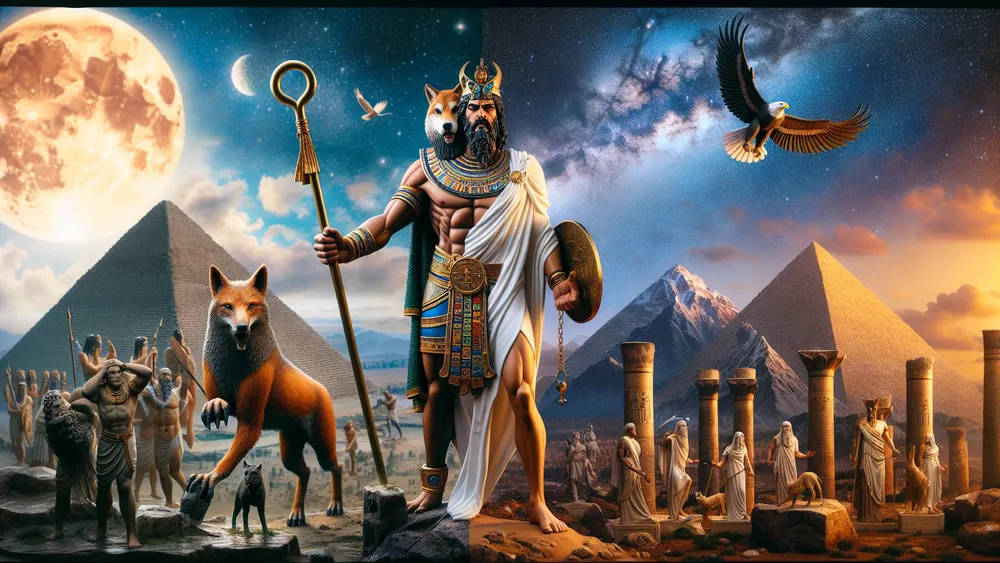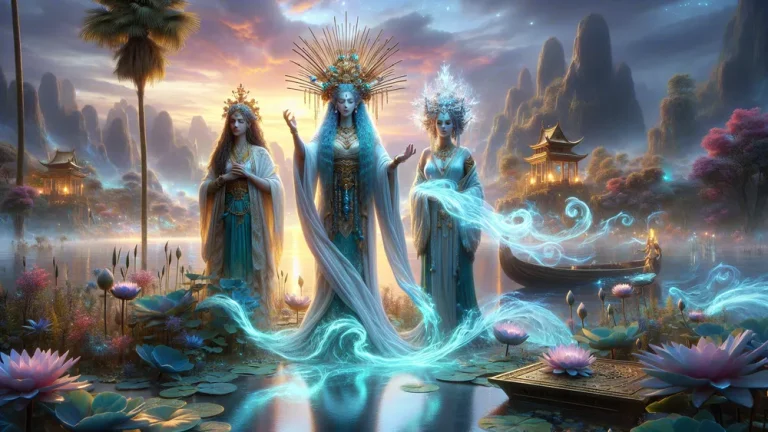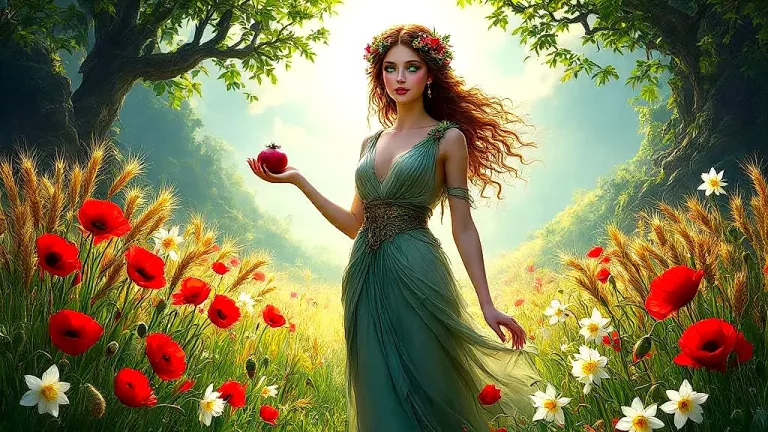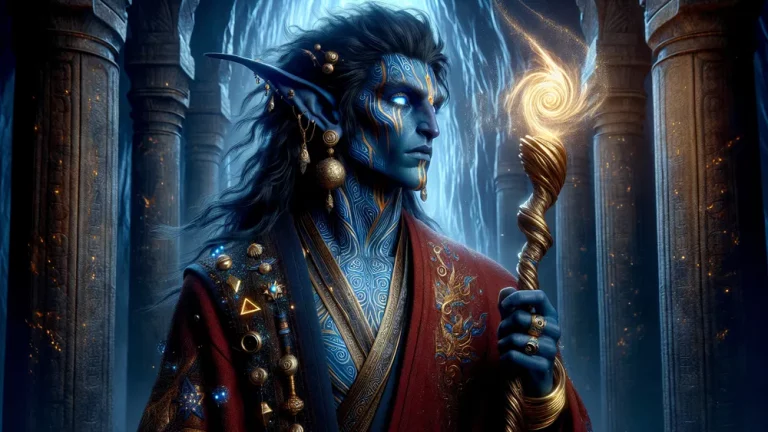Comparative Analysis: Egyptian Mythology Vs Greek Mythology
Stories, the deep mesh of tales people hand over through many years, are a great look into old beliefs and values of ancient lands. In this write-up, we will go on a look at two of the biggest old story traditions: Egyptian and Greek. You might wonder why these old stories still grab us today.
Key Points:
- Egyptian mythology originated around 3100 BCE, while Greek mythology began around 2000 BCE.
- Egyptian mythology focused on the afterlife and rituals, while Greek mythology centered on gods’ interactions with humans.
- Egyptian myths emphasized the pharaoh’s divine rule, while Greek myths showcased the Olympian gods.
- Major Egyptian deities include Osiris, Isis, and Horus, while Greek deities include Zeus, Hera, and Hades.
- Egyptian art featured pyramids and statues, while Greek art showcased temples and sculptures.
- Both mythologies still inspire modern literature, movies, and popular culture.
- The main differences lie in their creation myths, afterlife beliefs, and cultural influences.
Think of these stories as the old world’s version of a shared cultural collection, filled with tales that explain the mysteries of life, the universe, and human nature.
When we look at how they started, key ideas, and top gods of both Egyptian and Greek old tales, we can get a better understanding of how these stories shaped their lands and keep affecting today’s world.
Tales about how the world started or stories of gods and heroes, each part here will look at both unique and shared bits of these story traditions, offering a full view for both new readers and die-hard fans.
Egyptian Mythology Vs Greek Mythology: Overview and Key Facts
| Aspect | Egyptian Mythology | Greek Mythology |
|---|---|---|
| Origins | Started around 3100 BCE with the joining of Upper and Lower Egypt. | Grew around 2000 BCE, shaped by the Minoan and Mycenaean cultures. |
| Primary Texts | Pyramid Texts, Coffin Texts, Book of the Dead | The Iliad, The Odyssey, Theogony, Homer’s Hymns |
| Pantheon Structure | Polytheistic, with a complex order of gods and goddesses. | Polytheistic with a clear order led by the Olympian gods. |
| Creation Myths | Many creation myths, like the Heliopolitan, Memphite, and Hermopolitan. | Mainly the story of Chaos, Gaia, and the Titans leading to the Olympian gods. |
| Afterlife Beliefs | Strong focus on the afterlife, with detailed rituals and the idea of Ma’at. | Different beliefs, with the Underworld ruled by Hades and the Elysian Fields for heroes. |
| Major Deities | Osiris, Isis, Horus, Seth, Ptah, Re, Hathor, Anubis, Thoth, Bastet, Amon | Zeus, Hera, Hades, Poseidon, Hermes, Apollo, Artemis, Ares, Athena |
| Role of Myths | Explained natural things, justified the pharaoh’s divine rule, and guided moral behavior. | Explained natural things, human traits, and gave moral lessons. |
| Cultural Influence | Built into everyday life, politics, and art; shaped later Abrahamitic religions. | Shaped Western literature, art, philosophy, and modern storytelling. |
| Art and Architecture | Pyramids, temples, tomb paintings, and statues showing gods and pharaohs. | Temples, sculptures, pottery, and epic poetry showing gods and heroes. |
| Modern Legacy | Still inspires modern literature, movies, and popular culture. | Still affects modern literature, movies, philosophy, and popular culture. |
A Look at Egyptian and Greek Myths
To really understand the details and richness of both Egyptian and Greek old stories, we should look at their beginnings, main ideas, and the interesting stories that grabbed people for thousands of years.
Where They Came From and Their History
Egyptian myths started around 3100 BCE with the joining of Upper and Lower Egypt, based in the Nile River’s rich land, which made their gods and stories. Greek myths, however, began to start around 2000 BCE, shaped by the earlier Minoan and Mycenaean groups. Both changed over time, showing the changes in their social and government world. For example, Egyptian stories were linked to the pharaohs, who were seen as godly, while Greek stories often were about the Olympian gods and their meetings with people. These myths shaped their cultures a lot, changing religious practices, ruling, and everyday life. To sum up their growth:
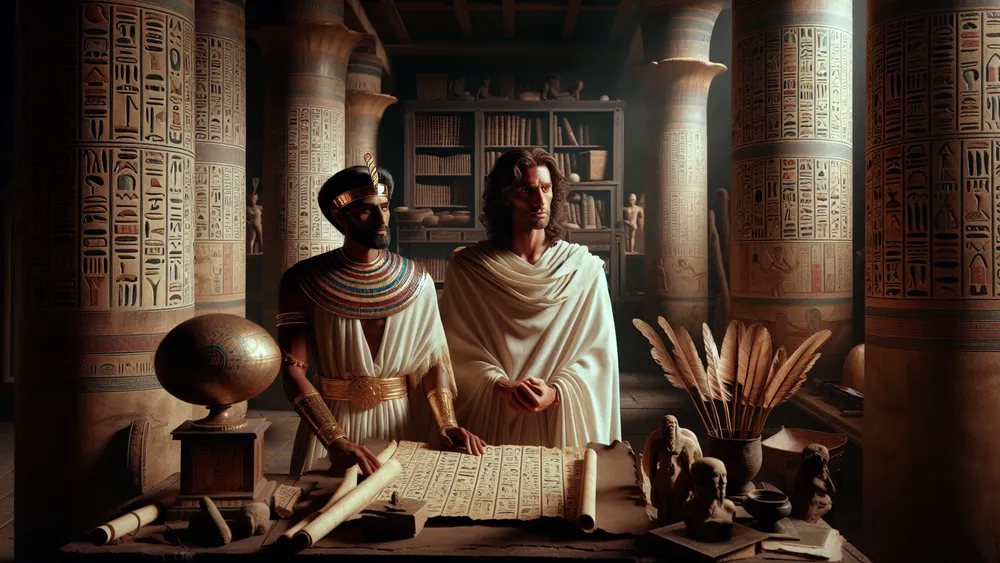
- Egyptian Myths: Started with the joining of Egypt, changed with the pharaohs’ godly rule, and were formed by the Nile’s cycles.
- Greek Myths: Began from Minoan and Mycenaean groups, changed through spoken stories, and were shaped by the city-states’ government actions.
If we know these beginnings and historical settings, we can understand better the rich mix of stories and beliefs that defined old Egyptian and Greek cultures.
Understanding the origins and historical contexts of Egyptian and Greek myths helps us comprehend the diverse stories and beliefs that influenced these ancient cultures significantly.
Big Ideas and Main Concepts
At the heart of both Egyptian and Greek old stories lie deep themes that show their cultures’ understanding of the world. Egyptian myths are filled with creation stories, for example, the Heliopolitan story where the god Atum makes the world from the first waters of Nun. But Greek myths start with Chaos, from which Gaia (Earth) and other first gods come out. Both mythologies put a lot of focus on the afterlife.
Egyptians believed in a long journey through the Duat (underworld) to get to the Field of Reeds. Greeks saw the Underworld ruled by Hades, with the Elysian Fields as a paradise for heroes. The roles of gods and goddesses also change. Egyptian gods like Osiris and Isis were linked with the pharaoh’s godly rule, while Greek gods like Zeus and Athena were more human-like, showing human traits and feelings. Key themes include:
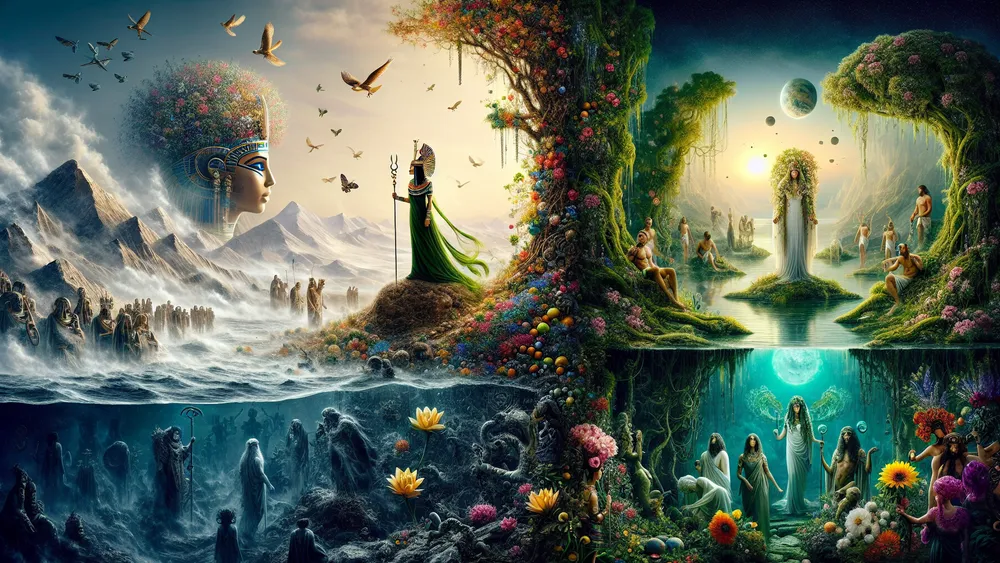
- Creation Myths: Egyptian stories often have gods making the world from chaos, while Greek stories start with first gods coming from Chaos.
- Afterlife: Egyptians had a long journey through the Duat, and Greeks believed in the Underworld with different places for the dead.
- Role of Deities: Egyptian gods were closely linked to the pharaoh’s godly rule, but Greek gods were more human-like and met with people often.
By looking at these big ideas and main concepts, we can see better how these old cultures saw their world and the godly forces that formed it.
The Gods and Goddesses
Now that we have looked at the main themes and ideas, we should look more into the groups of Egyptian and Greek old stories to see the roles and traits of their gods and goddesses.
Major Egyptian Gods and Goddesses
Egyptian myths have a lot of gods and goddesses, each playing a significant role in the universe and in everyday life. Osiris, the god of the afterlife, is often shown as a mummified king. He is connected with coming back to life and in deciding, much like a judge who decides the fate of souls. His wife Isis is the goddess of magic and motherhood, honored for her protective and healing powers.
Their son, Horus, is the sky god, often represented as a falcon and symbolizes kingship and protection. Seth, god of chaos and desert storms, is very different from his brother Osiris, as he symbolizes disorder and conflict. Ptah, the creator god, is linked with handiwork and building, like a master builder.
Re, the sun god, travels across the sky every day, bringing light and life, much like the sun’s role in keeping life on Earth.
To help you understand these gods and goddesses more:
| Deity | Role | Symbols | Traits |
|---|---|---|---|
| Osiris | God of the Afterlife | Crook and flail | Coming back to life, deciding |
| Isis | Goddess of Magic and Motherhood | Ankh, throne | Protection, healing |
| Horus | Sky God | Falcon, eye of Horus | Kingship, protection |
| Seth | God of Chaos and Desert Storms | Set animal, was-scepter | Disorder, conflict |
| Ptah | Creator God | Djed pillar, scepter | Handiwork, building |
| Re | Sun God | Sun disk, scarab | Light, life |
| Hathor | Goddess of Love and Music | Cow, sistrum | Joy, motherhood |
| Anubis | God of Mummification | Jackal, flail | Embalming, protection of the dead |
| Thoth | God of Wisdom and Writing | Ibis, scroll | Knowledge, writing |
| Bastet | Goddess of Home and Fertility | Cat, lioness | Protection, fertility |
| Amon | King of the Gods | Ram, ostrich feathers | Creation, hidden power |
Understanding the roles and traits of these major Egyptian gods and goddesses helps you see how they influenced old Egyptian culture and everyday life.
Major Greek Gods and Goddesses
In Greek myths, there is a group of gods and goddesses, each with important roles in the universe and people’s lives. Zeus, king of the gods, rulers the sky and uses the thunderbolt. He is like a top ruler who has the most power. Hera, his wife, is the goddess of marriage and family. She is often shown with a peacock, showing her royal status and watchfulness.
Hades, god of the underworld, rules the place of the dead, like a guardian of the afterlife. Poseidon, the god of the sea, controls the oceans and is usually shown with a trident, which represents his control over water. Hermes, the messenger god, is linked with travel and communication, much like a courier or diplomat now.
Apollo, the god of the sun, music, and future telling, represents the arts and knowledge. His twin sister, Artemis, is the goddess of the hunt and represents the wilderness and childbirth.
Here is a list to help understand these gods and goddesses more clearly:
- Zeus: King of the gods, ruler of the sky; symbols include the thunderbolt and eagle; traits are authority and justice.
- Hera: Goddess of marriage and family; symbols: the peacock and diadem; traits are loyalty and protection.
- Hades: God of the underworld; symbols: Cerberus and scepter; traits are wealth and death.
- Poseidon: God of the sea; symbols: trident and horse; traits are power and unpredictability.
- Hermes: Messenger god; symbols: caduceus and winged sandals; traits are speed and cunning.
- Apollo: God of the sun, music, and future telling; symbols: lyre and laurel wreath; traits are beauty and knowledge.
- Artemis: Goddess of the hunt and wilderness; symbols: bow and deer; traits are independence and protection.
- Ares: God of war; symbols: spear and helmet; traits are aggression and courage.
- Athena: Goddess of wisdom and warfare; symbols: owl and olive tree; traits are intelligence and strategy.
Seeing the roles and traits of these major Greek gods and goddesses helps to understand their influence on old Greek culture and everyday life.
Comparing the Gods and Goddesses
When looking at the gods and goddesses of Egyptian and Greek myths, we see clear similarities and big differences in their roles and traits. For instance, Zeus and Re (or Ra) are both top gods in their groups, ruling over the sky and showing power. But, Zeus uses a thunderbolt and is often like a father figure who directly connects with humans.
Re is linked to the sun and the daily trip across the sky, showing the cycle of life and death. Similarly, both groups have gods of the underworld – Hades in Greek myths and Osiris in Egyptian myths. Hades is more distant, overseeing the dead.
Meanwhile, Osiris is deeply involved in the deciding and coming back to life of souls, reflecting the Egyptians’ detailed ideas about the afterlife. The relationships between these gods and humans are also different. Greek gods often show human-like traits and emotions, engaging in direct connecting, conflicts, and even romantic connections with humans.
This human-like nature makes them easy to relate to but also changeable, as seen in myths where gods interfere in human lives, sometimes with bad ending. In contrast, Egyptian gods are generally more distant and symbolic, representing key parts of the natural world and cosmic order. They are worshipped through complex ceremonies and temple rituals, with the pharaoh being a go-between the gods and the people.
This difference shows how each culture saw the divine: Greeks viewed their gods as powerful but flawed beings while Egyptians revered their gods as forever and static forces of nature.

The gods in Egyptian and Greek myths have both similarities and differences in their roles and relationships with humans, with Greek gods displaying human-like traits and emotions, while Egyptian gods are more distant and symbolic, reflecting the cultures’ views on the divine.
Mythical Stories and Legends
After looking at the deities of Egyptian and Greek myths, we now move to myths and legends that these deities are part of.
Creation Myths
The creation myths of Egyptian and Greek stories give interesting views into how these old societies saw how the world started. In Egyptian mythology, the creation story often starts with Atum or Re coming from the first waters of Nun, showing the birth of order from mess. This story shows the Egyptians’ focus on balance in the universe. Greek mythology begins with Chaos.
From Chaos come Gaia (Earth), Tartarus (Underworld), and Eros (Love). This story is more lively. It involves following groups of gods taking over each other. This shows the Greeks’ view of a universe with constant change and fights. These different stories show unique cultural values: the Egyptians share an interest in balance and ongoing stability. The Greeks accept change and struggle as parts of life.
Hero Stories and Epic Tales
Hero stories and epic tales are central to both Egyptian and Greek myths, serving as stories that show the beliefs and ideas of their specific cultures. In Greek myths, heroes like Hercules (Heracles) are known for their amazing strength and courage. Hercules’ twelve tasks, which include killing the Nemean Lion and capturing the Golden Hind, are like a series of difficult tasks that test his heroism and endurance.
These stories not only entertain but also tell messages about never giving up, bravery, and the human fight against overwhelming challenges. Egyptian mythology, meanwhile, features heroes like Horus, who gets payback for his father Osiris by defeating the chaotic god Seth. Horus’ story is less about individual deeds and more about bringing back order and justice, reflecting the Egyptian focus on Ma’at, the idea of universal balance and harmony.
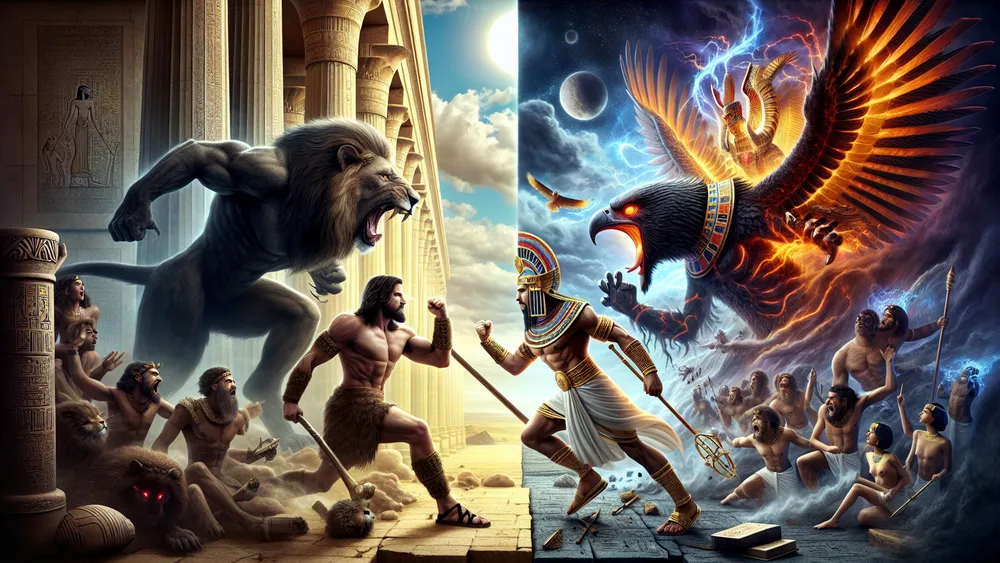
While Greek heroes often go on individual journeys that show their personal skill, Egyptian heroes are more often shown as part of a larger big fight. For example, the story of Horus and Seth is not just about personal payback but about the never-ending fight between order and chaos.
This difference highlights the different cultural values: Greek myths celebrate personal success and the hero’s journey, much like modern superhero stories, whereas Egyptian myths focus on the common good and the keeping of universal order. Despite these differences, both sets of myths serve to inspire and teach, offering timeless lessons that continue to connect with audiences today.
The Underworld and Afterlife
The ideas of the underworld and afterlife in Egyptian and Greek myths show how these old societies saw death and afterlife. In Greek mythology, Hades rules the dark place where souls go after death. It is a sad place, divided into areas like Elysium for the good and Tartarus for the bad. The journey to the underworld involves crossing the River Styx.
Charon, the ferryman, helps, which is like crossing into another world. Meanwhile, the Egyptian afterlife is detailed and more hopeful. The deceased face trials, like the heart weighing against the feather of Ma’at, watched by Osiris. Successful souls live forever in the Field of Reeds, a happy place that copies perfect earthly life.
Beliefs, ceremonies, and gods related to afterlife show more differences between these myths. Greek death rituals had offerings and ceremonies to ensure safe travel to the underworld, showing a practical relationship with gods. The Greeks felt proper burial rites were key for the soul’s peace, like in the Antigone story, where she buries her brother honorably against the king’s wish.
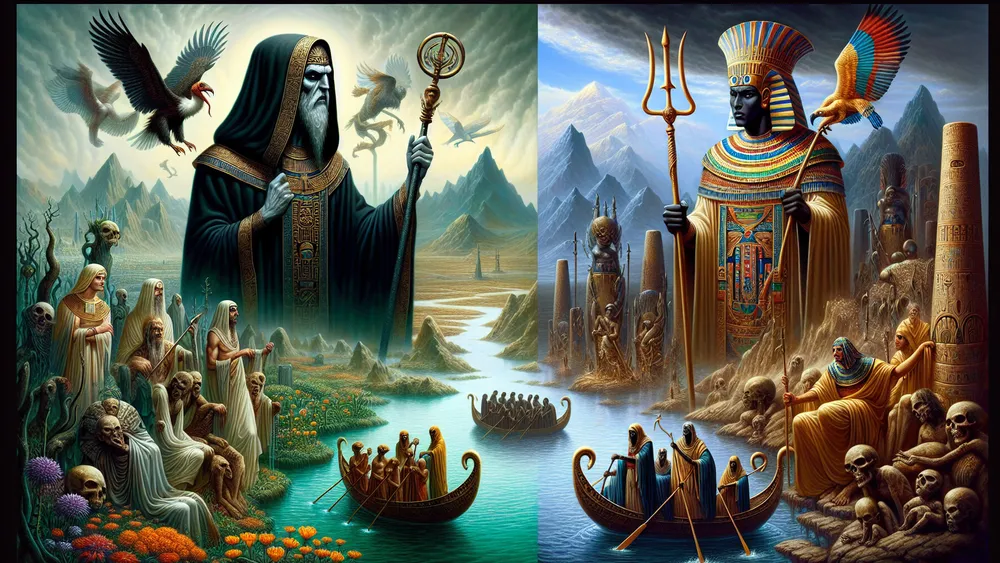
However, Egyptian rituals were tied to their religion, with mummification and grand tombs like pyramids for afterlife preparation. Gods like Anubis, in mummification, had big roles, highlighting the Egyptian focus on keeping the body for the soul’s journey. These practices show the Egyptians’ strong belief in an eternal afterlife, different from the Greeks’ sad and varied views of the underworld.
How It Shaped Culture and Everyday Life
After looking into the myths and tales of Egyptian and Greek myths, it is important to see how these old beliefs affected the everyday lives and ways of life of their people.
Religious Practices and Rituals
Religious practices and rituals in ancient Egypt and Greece were important to daily life and showed their mythologies. In Egypt, temples were not just worship places but also economic and political spots. Priests had important roles. They did daily rituals to respect the gods and ensure universal balance. For instance, every day they washed, dressed, and fed a deity’s statue in the temple.
This can be like caring for a highly valued guest. Greek religious practices, unlike Egyptian ones, were focused on the community, with temples as the main spots for group worship and festivals. Greek priests often worked part-time, while big public events such as the Olympic Games mixed sports with religious events. These differences highlight how each culture put their religious beliefs into their societies.
Egyptian rituals focused on keeping things the same and order, while Greek practices celebrated group involvement and personal achievement.
Art, Literature, and Buildings
The impact of Egyptian and Greek mythologies on art, books, and buildings is deep and long-lasting. In Egypt, the greatness of the pyramids and the detailed carvings in temples like Karnak and Luxor show their mythological beliefs, with hieroglyphs and statues showing gods, pharaohs, and myth stories. These buildings can be like modern-day monuments that honor important historical figures and events.
Greek mythology, on the other hand, inspired many books, such as Homer’s “Iliad” and “Odyssey,” which are long stories that people still read and adapt now. In terms of buildings, the Parthenon in Athens shows the Greeks’ respect for their gods, especially Athena, the city’s main deity.
The detailed sculptures and friezes on the Parthenon show mythological fights and godly figures, much like how modern murals might show historical or cultural stories. These artistic and architectural successes not only had religious uses but also supported cultural identity and values, making a big impact that continues to interest the modern world.
Modern Influence and Legacy
The modern impact and legacy of Egyptian and Greek myths can be clear in many parts of current culture, books, and media. These old stories still interest people, just like popular series now, like “Harry Potter” or “Star Wars”, draw on classic ideas.
Egyptian mythology, with its many symbols and gods, has inspired many books, movies, and even video games, like the “Assassin’s Creed” series, which puts players in ancient Egypt. In the same way, the group of gods and heroic stories from Greek mythology has made a lasting impact on modern stories, influencing superhero comics and films like “Wonder Woman” and “Percy Jackson.” These myths offer a lot of story ideas that connect with common human experiences, keeping their importance and appeal in today’s world.
By using these old traditions, today’s creators can look into deep ideas and people, connecting old and new times in a way that teaches and entertains.
FAQs
1. What are the main differences between Egyptian and Greek mythologies?
The main differences between Egyptian and Greek mythologies lie in their pantheons, creation myths, and views on the afterlife.
2. How did Egyptian and Greek mythologies influence each other?
Egyptian and Greek mythologies influenced each other through cultural exchanges facilitated by trade, conquest, and the interminglings of their respective civilizations.
3. Are there any similarities between Egyptian and Greek gods?
There are similarities between Egyptian and Greek gods in their roles as deities governing natural elements and human affairs.
4. Why are Egyptian and Greek mythologies still relevant today?
Egyptian and Greek mythologies are still relevant today because they continue to influence contemporary culture, literature, and media.

